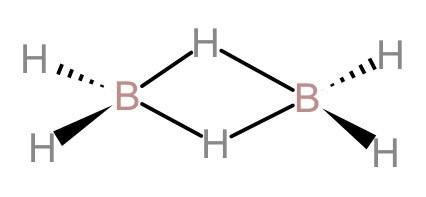
Answer
473.4k+ views
Hint: Diborane is a chemical compound which consists of two elements, boron and hydrogen. The chemical formula of diborane is ${B}_{2}{H}_{6}$. It is used as a reducing agent and is used as a catalyst for hydrocarbon polymerization.
Complete step by step solution:
Diborane is a colorless, pyrophoric gas. It has a repulsively sweet odor. Let us now look at the options one by one.
(A). In diborane 12 valence electrons are involved in bonding: Let us first look at the structure of diborane.

Now, by looking at the structure of diborane, we can see that there are 12 valence electrons that are involved in bonding. 8 valence electrons are used in the four non-bridging hydrogen bonds and four valence electrons are shared in forming 2-centered 2-electron bonds. Therefore, this statement is correct.
(B). In diborane, maximum six atoms, two boron and four terminal hydrogen, lie in the same plane: By looking at the structure of diborane, we can see that two boron atoms and the four terminal hydrogen atoms of the molecule are in the same plane. And the bridging hydrogen atoms lie above and below this plane. Therefore, this statement is also correct.
(C). Diborane has ethane-like structure: The structure of ethane has a single bond between the two carbon atoms but in diborane, there are bridged hydrogen-boron bonds. Therefore, it does not have an ethane-like structure. Hence, this is not correct.

(D). In diborane, bridging bonds are stronger and longer than the terminal bonds: The bridging hydrogen bonds in diborane are stronger, which means that the bridging H-atoms cannot be easily replaced in a chemical reaction. The length of the bridging hydrogen-boron bonds is $1.33 \overset {0}{A}$ which is longer than the length of the terminal hydrogen-boron length which is $1.19 \overset {0}{A}$. And we know that, the longer the bond, the stronger the bond. Therefore, the bridging bonds are stronger and longer than the terminal bonds. Hence, this statement is also correct.
Therefore, the correct statements are (A), (B) and (D).
Note: Diborane is known to be an electron deficient compound. It is highly reactive and a versatile reagent. It is also used as a rocket propellant. The complete combustion of diborane is strongly exothermic.
Complete step by step solution:
Diborane is a colorless, pyrophoric gas. It has a repulsively sweet odor. Let us now look at the options one by one.
(A). In diborane 12 valence electrons are involved in bonding: Let us first look at the structure of diborane.

Now, by looking at the structure of diborane, we can see that there are 12 valence electrons that are involved in bonding. 8 valence electrons are used in the four non-bridging hydrogen bonds and four valence electrons are shared in forming 2-centered 2-electron bonds. Therefore, this statement is correct.
(B). In diborane, maximum six atoms, two boron and four terminal hydrogen, lie in the same plane: By looking at the structure of diborane, we can see that two boron atoms and the four terminal hydrogen atoms of the molecule are in the same plane. And the bridging hydrogen atoms lie above and below this plane. Therefore, this statement is also correct.
(C). Diborane has ethane-like structure: The structure of ethane has a single bond between the two carbon atoms but in diborane, there are bridged hydrogen-boron bonds. Therefore, it does not have an ethane-like structure. Hence, this is not correct.

(D). In diborane, bridging bonds are stronger and longer than the terminal bonds: The bridging hydrogen bonds in diborane are stronger, which means that the bridging H-atoms cannot be easily replaced in a chemical reaction. The length of the bridging hydrogen-boron bonds is $1.33 \overset {0}{A}$ which is longer than the length of the terminal hydrogen-boron length which is $1.19 \overset {0}{A}$. And we know that, the longer the bond, the stronger the bond. Therefore, the bridging bonds are stronger and longer than the terminal bonds. Hence, this statement is also correct.
Therefore, the correct statements are (A), (B) and (D).
Note: Diborane is known to be an electron deficient compound. It is highly reactive and a versatile reagent. It is also used as a rocket propellant. The complete combustion of diborane is strongly exothermic.
Recently Updated Pages
Fill in the blanks with a suitable option She showed class 10 english CBSE

TISCO is located on the banks of which river A Tungabhadra class 10 social science CBSE

What is greed for clothes A Simply desire to have them class 10 social science CBSE

What does the 17th Parallel line separate A South and class 10 social science CBSE

The original home of the gypsies was A Egypt B Russia class 10 social science CBSE

The angle between the true north south line and the class 10 social science CBSE

Trending doubts
Fill the blanks with the suitable prepositions 1 The class 9 english CBSE

How do you graph the function fx 4x class 9 maths CBSE

Which are the Top 10 Largest Countries of the World?

Which is the longest day and shortest night in the class 11 sst CBSE

What is the definite integral of zero a constant b class 12 maths CBSE

Name five important trees found in the tropical evergreen class 10 social studies CBSE

The Equation xxx + 2 is Satisfied when x is Equal to Class 10 Maths

Differentiate between homogeneous and heterogeneous class 12 chemistry CBSE

Difference between Prokaryotic cell and Eukaryotic class 11 biology CBSE




